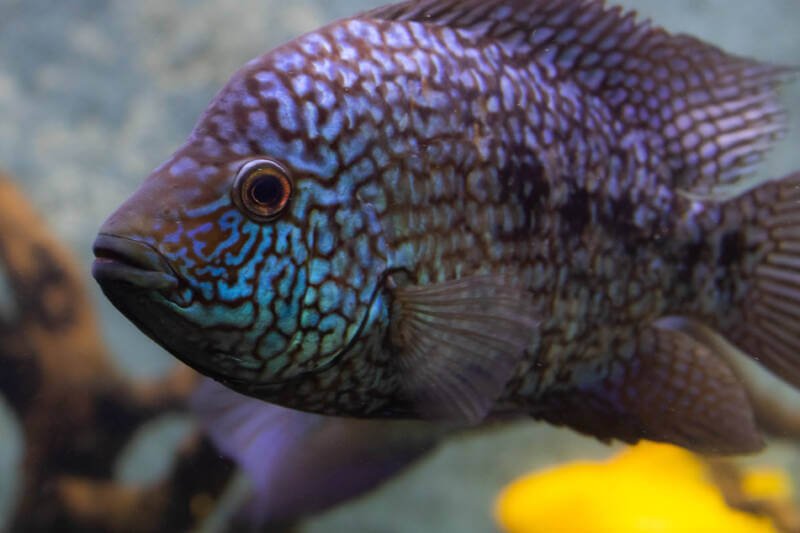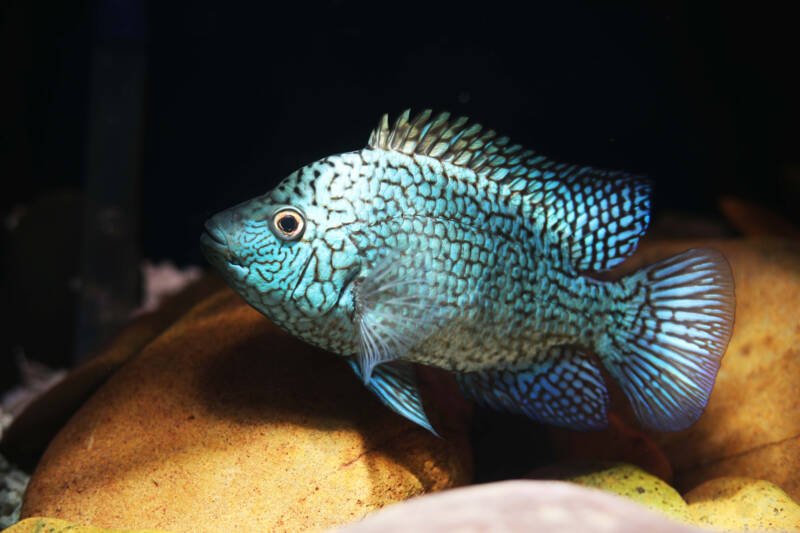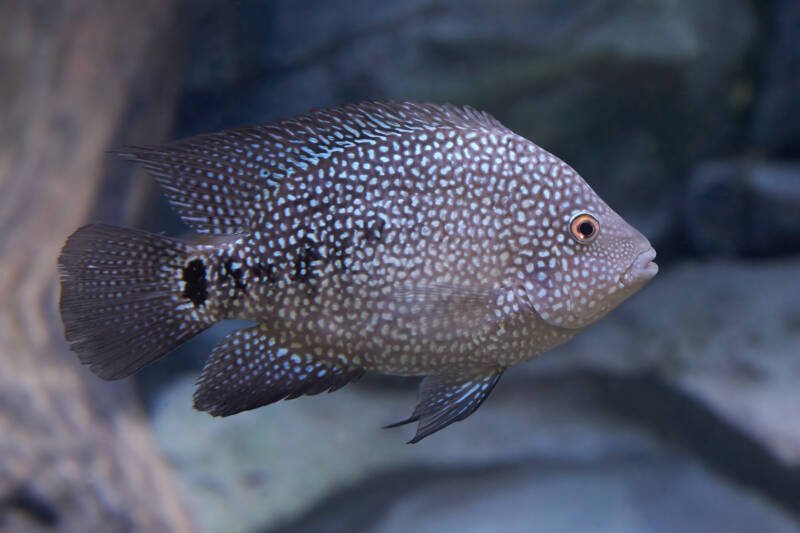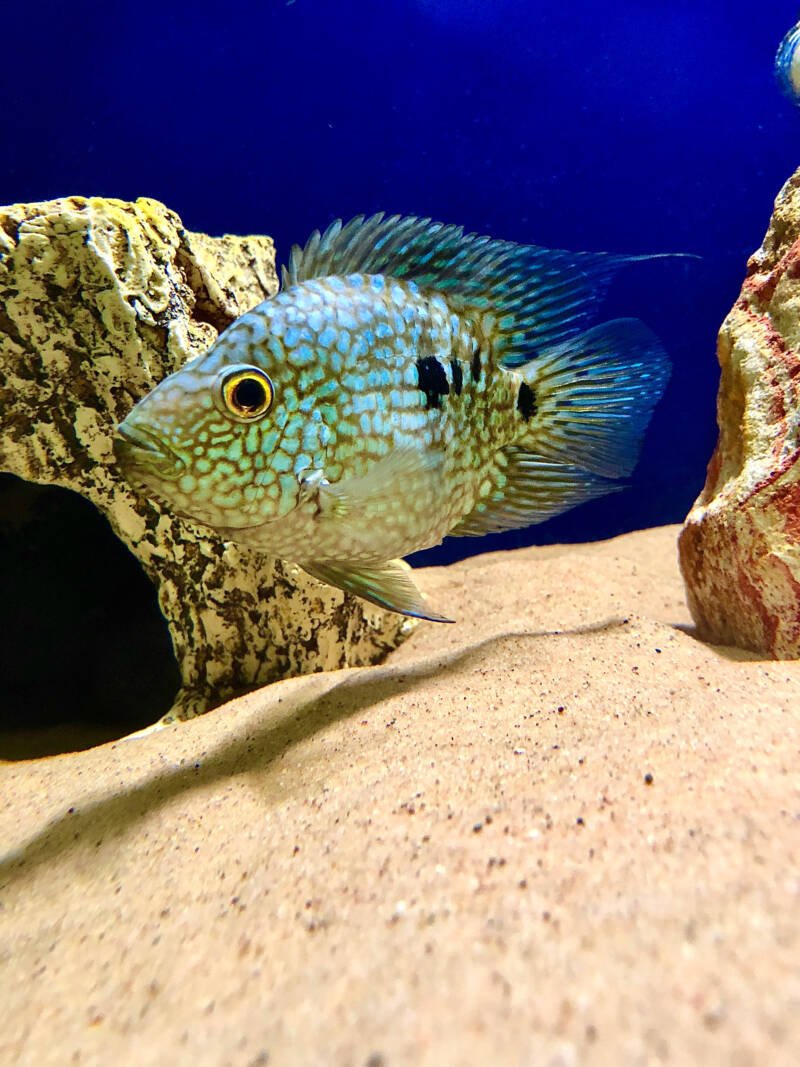In the southern part of the Lone Star State lives a beauty of a fish with an attitude as big as Texas.

Covered in shimmering blue spots that catch the light and almost glow, it is clear to see why the Texas cichlid is a favorite for its looks.
This active fish has a feisty personality that can make it a challenge for even experienced aquarium keepers.
Those taking on the Texas cichlid should consider a few special requirements to keep this fish healthy and long-lived.

Read on for more information on how to care for the Texas cichlid as well as answers to some commonly asked questions.
At a Glance
| Tank Size: | 55 gallons (for a single cichlid) |
| Group Size: | Kept single or in small groups in a large tank |
| Water Temperature: | 68 to 78°F (20 to 26°C) |
| pH: | 6.5 to 8 |
| Hardness: | 5 to 15 dGH |
| Lifespan: | 10 to 13 years |
| Breeding: | Egg layer |
| Adult Size: | 12 inches (30 cm) |
| Usual Place in the Tank: | All levels |
In this article
Natural Habitat
This freshwater species is found in southern Texas and northern Mexico, mostly in the lower Rio Grande River.
According to the Texas Parks and Wildlife division, this fish has also been found in central Texas’ San Marcos, Guadalupe, San Antonio, and Colorado rivers.
The Texas cichlid is a warm water fish and cannot tolerate temperatures below 49 degrees Fahrenheit (9 degrees C).
The lakes and rivers this fish calls home have variable currents and water that is slightly acidic. The riverbeds have a sandy substrate with some rocks and submerged vegetation.
Appearance and Biology
Texas cichlid (Herichthys cyanoguttatus) is also called the Rio Grande perch, the Rio Grande cichlid, or the pearl cichlid.
Its body is oval-shaped and compressed laterally, giving it that sleek, predator look. The base color of the Texas cichlid ranges from a dark gray to light green.
Starting around the mid-body and extending toward the tail are a series of up to five larger black spots in a horizontal line. These spots can sometimes appear as extended dark, vertical bands.
The rayed dorsal and anal fins sweep backward toward a blunt tail. The anal fin has five or six spines.
Then there are the dots. The second part of the Texas cichlid’s scientific name, cyanoguttatus, means “blue spotted”. An apt description, this fish features iridescent blue dots covering its body from head to tail, making for a striking appearance.
You may hear of color variations that are also called “Texas cichlids.” However, some of them (the red Texas cichlid and the green Texas cichlid) are hybrids and not true Texas cichlids.
The electric blue Texas cichlid is a color variation with vibrant light blue dots and a light green base color.

Do Texas cichlids grow fast?
Yes. When you first purchase them, they will be only a few inches in length and add on four inches or so in the first six months. Over time, they will grow to their adult length of 12 inches.
Do Texas cichlids have teeth?
Yes. The teeth on its jaw are mostly cone-shaped, but it also has flat teeth.
Gender Differences

How can I tell if my Texas cichlid is male or female?
In adult Texas cichlids, you may notice a nuchal hump on the males. This hump can be more pronounced when the fish is ready to breed.

Females also have a black spot on their dorsal fin.
Size
A fully grown adult Texas cichlid can reach up to 12 inches (30.5 cm) in length.
Lifespan
This cichlid species has a very long lifespan of 10 to 13 years. Proper care is a must to allow this cichlid species to live a long and healthy life.
Behavior
Texas cichlids have several interesting behaviors. For one, they are quite smart. You may see them approach the glass at feeding time and react to your presence.
They are not schooling or shoaling fish and prefer to actively swim in all areas of the tank. They especially enjoy digging in the substrate and swimming in the open spaces.
How aggressive are Texas cichlids?
Texas cichlids are aggressive fish. They are highly territorial and are semi-tolerant of others in their space, even their own species.
The best way to temper this aggression, especially if you are planning a community tank, is to have adequate space and plenty of hiding places. This will allow the fish to establish territories and to retreat and shelter as needed.
How many per gallon?
You can forget the standard stocking limit recommendations. This cichlid requires wide-open Texas spaces – in water form.
Plan on at least a 55-gallon tank if you are keeping a single cichlid. This is the minimum tank size.Upwards of 125 gallons are required if you are planning on keeping additional fish.
Why so many gallons? If this fish does not have enough room to swim, then they can tend toward more aggressive behavior.
Tank Setup

Once you have decided on an appropriate tank size, setting up your Texas cichlid tank is not difficult.
The biggest considerations are their need for adequate swimming space, their tendency to dig, and their requirement for good, stable water conditions.
Decorations
To replicate their natural habitat, line the bottom of the tank with a sandy substrate. Including some gravel and/or rocks is fine as well.
Texas cichlids love to rearrange their habitats. Secure any decorations that you would like to keep stationary to the bottom of the tank.
Add pieces of driftwood or rocks along the bottom to create hiding places.

Include artificial or live plants but place them so that there is ample swimming space. Try adding some floating plants for shade and a natural feel.
Water Conditions
For the best health and growth of your fish, maintain stable water conditions. These fish can tolerate a range of water temperatures but keep them on the warm side.
Anything in the range of 68 to 78 degrees Fahrenheit (20 to 26 degrees C) is fine, just keep the temperature consistent.
The pH level should be between 6.5 and 8 and the hardness between 5 to 15 dGH. Perform regular water changes to prevent the buildup of ammonia and nitrates.
Equipment
To keep the water temperature consistent, install a heater on your tank. Add a sturdy external canister filter that can produce a moderate water flow.
In addition, a tight fitting or well-secured lid on your tank is a good idea.
Tank Mates
The Texas cichlid is a species that can be kept on its own. With their highly territorial nature, you may see aggression if you pair them with another fish, even another Texas cichlid.
If you have a large enough tank size, however, there are some species that can pair well.
The ideal tank mates will be of similar size and temperament, that is, larger aggressive and semi-aggressive species.
Consider the following additional species to pair with your Texas cichlid:
- Other cichlids (green terror, convict, ram, Jack Dempsey, or firemouth)
- Plecos
- Giant gouramis.
Avoid the following:
- Any smaller, peaceful, or shy species.
Can a Texas cichlid live with an oscar?
Yes. An Oscar is the right size and temperament to pair with a Texas cichlid in an appropriately sized tank.
Food and Diet
What do Texas cichlids eat? These fish are omnivores and will readily accept a variety of foods.
In the wild, they eat fish, crustaceans, insects, eggs, and plant matter.
In an aquarium, the base of their diet should be a high-quality commercial flake or pellet.
Feed your fish twice daily and only as much as they can finish in a few minutes. Leftover food will decay and can significantly impact your water quality.
To round out their diet, include the following treats every now and then:
- Bloodworms
- Insects
- Brine shrimp (fresh or frozen)
- Blanched vegetables.
Avoid feeding your fish:
- Mammal flesh (it is too fatty for your fish)
- Fresh feeder fish as rosy red minnows (unless they are from a reputable source, they can be a source of contamination in your tank).
Breeding
Breeding your Texas cichlid is not difficult.
Setting up a Breeding Tank
You will need a dedicated breeding tank of at least 75 gallons. The water should have the same parameters as the community tank as far as temperature, pH, and hardness.
Include sandy substrate and a flat rock. Your cichlids may use either for laying their eggs.
Breeding Behavior and Spawning
After your fish have been conditioned with some high-protein foods, you may notice courting behavior. This can include chasing, striking with the tail, and face-to-face contact.
If the courtship is a success, the fish will change color. The back half of their body will turn dark while the front will become pale.
Your fish may dig a pit in which to lay their eggs, or the female may lay them on the flat rock. She can lay anywhere from 500 to 1,000 eggs at a time.
Hatching ad Care of Fry
The fertilized eggs will take three days to hatch. During this time, both parents will guard the eggs, fanning them with their pectoral fins to increase oxygen supply.
The newly hatched fry will live off their egg sacs for up to five days before they become free-swimming.Once that happens, you can feed them baby brine shrimp, nauplii, and spirulina.
Hardiness
While the Texas cichlid is hardy, poor water quality can increase its susceptibility to common tank diseases.
As with many freshwater fish species, a primary concern is ich. This parasitic infection results in white spots on your fish’s body.Treat it quickly by isolating the infected fish, correcting any poor water or tank conditions, and administering in-water medication.
Another potential ailment to look out for is fin rot, which can be more prevalent in a tank with poor conditions.
Treat this infection quickly to avoid further damage to the fins. Correct all water conditions, isolate the infected fish and treat with over-the-counter medications or an antibiotic prescribed by a veterinarian.
Closing Thoughts
This is not necessarily the best fish for beginners. A little background in fish keeping, especially with cichlids, can be beneficial when keeping the Texas cichlid.
This fish requires a large tank, does not always pair well with others, and requires consistent water conditions.
However, the effort is not without reward. The Texas cichlid is a beautiful addition to a tank and is an extremely active and intelligent species.Those ready to take on the challenge are sure to enjoy this interesting and lovely fish.
What are your experiences keeping a Texas cichlid?
With what fish species have you successfully paired them in a community tank?
We would love to hear from you in the comments below!